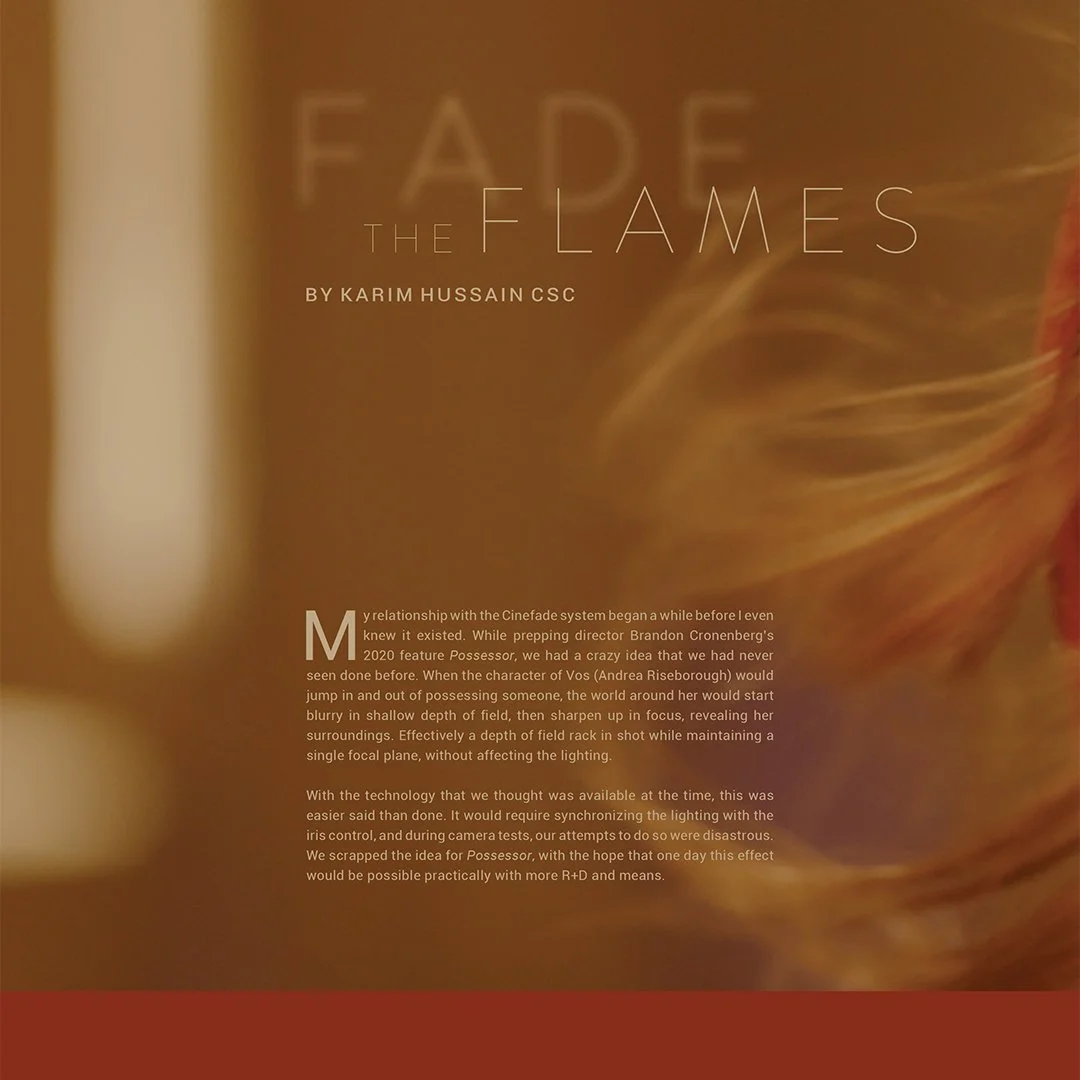Cinefade System
Our cmotion Cinefade VariND consists of a Motorised Polariser and a Static Polariser. When inserted into a matte box together they form a variable ND filter.
A cmotion cPro or ARRI Hi-5 lens control system slaves an iris motor to the Cinefade VariND, enabling cinematographers to vary depth of field at constant exposure. The in-camera effect is remotely controlled with the cPro or Hi-5 hand unit.
How Cinefade works
The iris is operated to vary depth of field.
Varying iris diameter changes depth of field, which gradually blurs or sharpens the background while the foreground remains in focus. Opening and closing the aperture however also affects exposure.
Cinefade compensates for the exposure change by slaving a variable ND filter to the iris motor. Whenever the iris is opened and lets in more light, the light filter automatically decreases light transmission, allowing less light to pass through.
Our variable ND filter automatically keeps exposure constant.
After mapping the lens into the system, the User simply sets the base exposure with the iris slider (which becomes the position of deepest depth of field), eg. T11 and activates the Cinefade mode by pushing a button on the hand unit. The iris motor and cmotion Cinefade Filter are now slaved to each other.
The User then simply opens up the lens up to a maximum of 5 T-stops by operating the iris slider and the system automatically keeps the exposure constant.
Cinefade Vari360 Upgrade
+ 360° rotation of the RotaPola
+ Built-in 3-axis gyro-sensor to compensate camera rotation
+ Compatible with ARRI Hi-5
Features
Quick and easy setup
The cmotion Cinefade VariND is simply connected to the receiver with an LBUS cable. Once the lens is mapped, the Operator sets the base exposure and activates the Cinefade mode on the hand unit.
Compatible with all cameras and cine-lenses
The system is independent of the camera and works with all digital and analogue film cameras. Cinema lenses with a geared aperture ring and accurate T-stop markings are necessary. During lens mapping, modern and rehoused lenses tend to perform better than vintage lenses, which can have inaccurate T-stop markings.
ANy Cinefade range up to 5 stops
The base exposure becomes the position of ‘deep depth of field’ (eg. T11). It is possible to transition up to 5 T-stops between the deep position and the shallow position (eg. T2). A higher range is achievable by accepting a slight colour cast, which is easily corrected in post-production.
0.5 sec max Cinefade speed
The Cinefade effect is controlled manually via the iris slider and has a maximum speed of half a second for a 5 stop Cinefade range. An automatic control will become available through a future software upgrade/firmware licence.
Only 1.5 stops initial light loss
At full transmission the variable ND filter blocks 1.5 stops of light, requiring an exposure compensation: A Cinefade range starting at T11 requires a light meter reading of T16½ to achieve a good exposure.
No loss in optical quality
The cmotion Cinefade VariND uses custom ARRI polarisers that produce no colour shift or undesirable artefacts. The variable ND filter shows no changes in polarisation effects when rotating the polariser closest to the camera.
Compatible with cmotion & ARRI
Cinefade is compatible with the cmotion cPRO and ARRI Hi-5 lens control systems.
Latest Cinefade updates



























The Cinefade VariND and upgraded Cinefade Vari360 are now fully compatible with the ARRI Hi-5 lens control system via the Hi-5 Cinefade license key.
The Hi-5 Cinefade license is available from the ARRI Shop for €350. Once the license is installed on your Hi-5 hand unit, you can use all Cinefade features — the variable depth-of-field effect, VariND mode, and RotaPola mode — just as you would with a cmotion cPro lens control system.